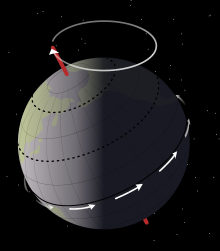A Pole Star In The Sky
A pole star or polar star is a star, preferably bright, closely aligned to the axis of rotation of an astronomical object.
With regard to planet Earth, the pole star refers to Polaris, a magnitude 2 star aligned approximately with its northern axis, and a per-eminent star in celestial navigation.
History
In classical antiquity, Beta Ursa Minors was closer to the celestial north pole than Alpha Ursa Minors. While there was no naked- eye star close to the pole, the midpoint between Alpha and Beta Ursa Minors was reasonably close to the pole, and it appears that the entire constellation of Ursa Minor, in antiquity known as Cynosure was used as indicating the northern direction for the purpose of navigation by the Phoenicians. The ancient name of Ursa Minor, anglicized as cynosure, has since itself become a term for "guiding principle" after the constellation's use in navigation.
It was still removed from the celestial pole by about 8°. It was known as spic-storage ("ship-star") in 10th-century Anglo-Saxon England, reflecting its use in navigation. At around the same time, in the Hindu Purana, it became personified under the name Duvalier.
In the medieval period, Polaris was also known as Stella maria "star of the sea" (from its use for navigation at sea), as in e.g. Bartholomew Anglicans, in the translation of John Trevino :
By the place of this stereo place and steeds and bounded of the other Forrester and of circles of even Ben known: therefore astronomers behold moose this stereo. Then this steer is discovery of the most short circle; for he is freer from the place that we Ben in; he Hyde the hugeness of his quantity for unmevablenes of his place, and he doth fierce men most certainly, that behold and take hedge thereof; and therefore he is called Stella Maris, the stereo of the see, for he Lethe in the see men that Sallee and have mannishness craft.
Polaris was associated with Marian veneration from an early time Our lady star of the sea being a title of the Blessed Virgin.
This tradition goes back to a misreading of Saint Jerome's translation of Eugenius Iconoclastic , De no minibus Hebraic (written ca. 390). Jerome gave stills Maris "drop of the sea" as a (false) Hebrew etymology of the name Maria . This stills Maris was later misread as Stella Maris; the misreading is also found in the manuscript tradition of Isidore's Etymological (7th century); it probably arises in the Ca rolling era; a late 9th-century manuscript of Jerome's text still has stills, not Stella, but Paschal Tuberous,
also writing in the 9th century, makes an explicit reference to the
"Star of the Sea" metaphor, saying that Mary is the "Star of the Sea" to
be followed on the way to Christ, "lest we capsize amid the
storm-tossed waves of the sea."
The name Stella Polaris was coined in the Renaissance,
even though at that time it was well recognized that it was several
degrees away from the celestial pole; Gem ma Sirius in the year 1547 determined this distance as 3°7'.
An explicit identification of Mary as Stella Maris with the North Star (Polaris) becomes evident in the title Cynosure sue Mariana Stella Polaris
(i.e. "Cynosure, or the Marian Polar Star"), a collection of Marian
poetry published by Nicolas Licenses (Niccolo Besotting de Luca) in
1655
Procession of the equinoxes
As of October 2012, Polaris had the declination +89°19′8″ (at epoch J2000
it was +89°15′51.2″). Therefore, it always appears due north in the sky
to a precision better than one degree, and the angle it makes with
respect to the true horizon (after correcting for refraction and other
factors) is equal to the latitude of the observer to better than one
degree.
The celestial pole will be nearest Polaris in 2100 and will thereafter
become more distant.
Due to the procession of the equinoxes (as well as the stars' proper motions), the role of North Star has
passed (and will pass) from one star to another in the remote past (and
in the remote future). In 3000 BC, the faint star Thu ban in the constellation Draco was the North Star. At magnitude 3.67 (fourth magnitude) it is only one-fifth as bright as Polaris, and today it is invisible in light polluted urban skies.
During the 1st millennium BC, Beta Ursa Minors ("Kochab") was the bright star closest to the celestial pole, but it
was never close enough to be taken as marking the pole, and the Greek
navigator Pythias in ca. 320 BC described the celestial pole as devoid of stars In the Roman era, the celestial pole was about equally distant between Polaris and Kochab.
Southern pole star (South Star)
Currently, there is no South Star as useful as Polaris.Sigma Oct antis is the closest naked-eye star to the south Celestial pole, but at apparent magnitude 5.45 it is barely visible on a clear night, making it unusable for navigational purposes .
It is a yellow giant 275 light years from Earth. Its angular separation from the pole is about 1° (as of 2000 the southern pole constellation functions as an approximate southern pole constellation, by pointing to where a southern pole star would be.
At the equator, it is possible to see both Polaris and the Southern Cross.
The Celestial south pole is moving toward the Southern Cross, which has
pointed to the south pole for the last 2000 years or so. As a
consequence, the constellation is no longer visible from subtropical
northern latitudes, as it was in the time of the ancient Greeks.


No comments:
Post a Comment